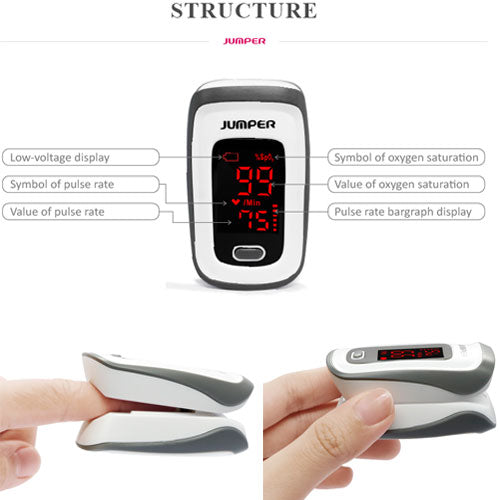Description
HOW TO USE YOUR PULSE OXIMETER
Specifications
|
Display Information |
Display Mode |
|
Display Format |
LED display |
|
The Pulse Oxygen Saturation (SpO2) |
Digital |
|
Pulse Rate (PR) |
Digital |
|
Pulse Intensity (bar-graph) |
Digital bar-graph display |
|
SpO2 Parameter Specification |
|
|
Measuring range |
35%-100% (the resolution is 1%). |
|
Accuracy |
70%-100%;±2%, Below 70% unspecified. |
|
Pulse Parameter Specification |
|
|
Measuring range |
25bpm-250bpm (the resolution is 1 bpm) |
|
Accuracy |
±2bpm |
|
Pulse Intensity |
|
|
Range |
Continuous bar-graph display, the higher display indicates the stronger pulse. |
|
SpO2 |
Less than 94% |
|
PR |
Less than 50bpm or more than 130bpm |
|
Battery Requirement |
|
|
2 X 1.5V (AAA size) alkaline battery |
|
|
Power Consumption |
|
|
Smaller than 35 mA. |
|
|
Battery Useful Life |
|
|
Two batteries can work continually for 24 hours |
|
|
Power off |
|
|
The Oximeter can be powered off in case no finger is the Oximeter within 16 seconds. |
|
|
Optical Sensor |
|
|
Red light (wavelength is 660nm) Infrared (wavelength is 905nm) |
|
|
Dimensions and Weight |
|
|
Dimensions |
62 (L)X37 (W)X32(H) mm |
|
Weight |
About 50g (with the batteries) |
What is SPO2 mean
A normal healthy person should be able to achieve normal blood oxygen saturation levels (SpO2) of 94% to 99%. For patients with mild respiratory diseases, the SpO2 should be 90% or above. Supplementary oxygen should be used if SpO2 level falls below 90%, which is unacceptable for a prolonged period of time.
Pulse Rate
Your pulse is your heart rate, or the number of times your heart beats in one minute. Pulse rates vary from person to person. Your pulse is lower when you are at rest and increases when you exercise (more oxygen-rich blood is needed by the body when you exercise). Most people the regular pulse rate is 60 beats a minute. however if the pulse rate drops to 50 beats/Min or less than this is known as bradycardia.
The main symptom of bradycardia is a heart rate below 60 beats per minute. This abnormally low heart rate can cause the brain and other organs to become oxygen-deprived, which can lead to symptoms such as:
- Fainting
- Dizziness
- Fatigue
- Weakness
- Shortness of breath
- Chest pain
- Confusion
- Memory difficulties
- Quickly tiring during physical activity
Payment & Security
Payment methods
Your payment information is processed securely. We do not store credit card details nor have access to your credit card information.
Security


